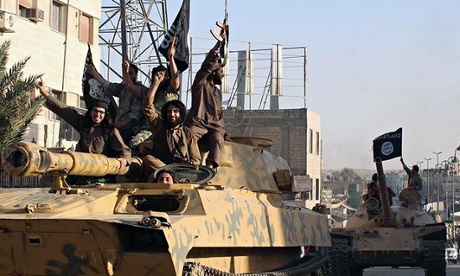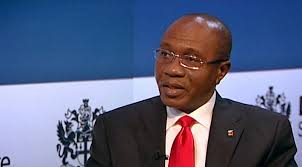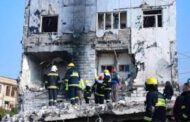sis fighters during a parade in Raqqa, Syria. Photograph: AP
Middle Eastern governments formally signed on to Barack Obama’s war coalition against the Islamic State (Isis) on Thursday, even as major questions remained about the expansion of the air war into Syrian territory the jihadist army controls.
A day after Obama told the US public that the latest war in the skies above Iraq will soon cross the border into Syria, he received a major diplomatic boost from the leaders of Egypt, Iraq, Jordan, Lebanon and the Gulf Cooperation Council – an alliance of the Sunni Arab Gulf nations, including Saudi Arabia, Qatar and the United Arab Emirates – who pledged to “stand united” against “the so-called Islamic State in Iraq and the Levant.”
In a document known as the Jeddah Communique, issued after intense diplomacy from US secretary of state John Kerry in the Saudi city, the signatories agreed to staunch Isis funding and influx of foreign fighters, critical priorities for Washington. They expressed openness to contributing directly to the war effort, saying they would be “as appropriate, joining in the many aspects of a coordinated military campaign” against Isis.
Many of the Gulf signatories have operated weapons and cash pipelines to Syrian rebels, including extremist groups, that have redounded to Isis’s benefit. Saudi Arabia’s royal family, usually loath to criticize its US partner, has excoriated Obama for what it considers insufficient action against Syrian dictator Bashar al-Assad and Iran, yet the Saudis have now agreed to host the training of Syrian rebel groups for the US military, effectively aligning themselves with regional rival Iran against the mutual Isis foe.
The ability of those Syrian rebel groups to take and hold terrain away from Isis and reap the benefits of forthcoming US airstrikes are amongst the major questions surrounding Obama’s anti-Isis strategy. Another is Assad’s willingness to allow US warplanes access to Syrian skies, even for strikes against a mutual foe, as Obama reiterated a commitment to his ouster and will be training rebels who seek his overthrow as well as Isis’ downfall.
Army general Martin Dempsey, the chairman of the Joint Chiefs of Staff who has long viewed US military action in Syria with skepticism, told Congress last year that training a rebel force would cost $500m per year – the sum Obama is asking Congress to approve. He has also frequently worried about the formidability of Assad’s air defenses, a mixture of Soviet-era missiles and jets, mostly along Syria’s western coast.
As Obama has warmed in recent weeks to expanding the air war into Syria, US officials have mused that the territory they sought to take from Isis is in the east, rendering the skies there a more permissible environment than in Assad’s coastal strongholds.
Retired air force lieutenant general David Deptula, a former branch intelligence chief and Desert Storm attack planner, warned that some of Syria’s defenses were mobile, mounted on trucks,
“It’s a complex situation but not impossible,” Deptula said, as Syrians have had to defend their skies against the sophisticated Israeli air force. He advocated issuing a diplomatic demarche “to say, we’re conducting operations against Isis and if any of your air defenses threaten any of our forces they’ll be dealt with accordingly, and we need to be prepared to do that.”
Christopher Harmer, a former US navy officer, said Assad’s air defenses are overrated, and cited by Pentagon officials as an excuse for inaction. “Once they turn on the tracking radar … we’re going to have a dozen anti-radiation missiles go after it. I can’t imagine the Assad regime would be dumb enough to impede our progress,” he said.
Assad and his Russian and Iranian sponsors warned the US on Thursday against striking regime targets. But Assad’s deputy foreign minister, Faisal Mekdad, told NBC that Assad would have “no reservations whatsoever” about US air strikes against Isis, a prospect the Assad regime appears to be gambling it can trade for tacit US acceptance of its survival.
A more substantial problem, military experts said, will be developing Isis targets in eastern, where US intelligence networks are believed to be slim – something the rebel training may alleviate. Isis is entrenched in cities like Raqqa and intermingled with civilian infrastructure, blunting the advantages of US air power and daring Washington to inflict civilian casualties.
It is also unclear if US military trainers will enter Syria alongside retrained rebels to call in airstrikes from US pilots. Without US spotters on the ground, an effective air campaign in Syria will be reliant on the rebels, Harmer said, a process that would take months or longer to develop trust.
“These guys are going to take a lot of training before they can call in airstrikes, and if not, then we’re acknowledging it’s a static air war scenario,” said Harmer, now an analyst for the Institute for the Study of War.
“That’s step one in a 10-step process. It worked well in March and April 2003” in Iraq as the US invasion took Baghdad, but afterward, US pilots found themselves frustrated by “a human network extremely difficult to attack” from above.














